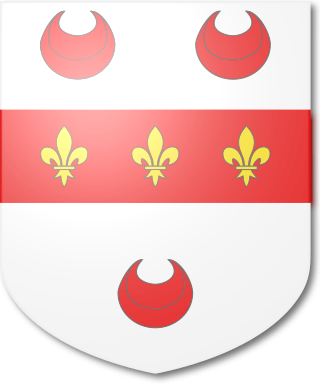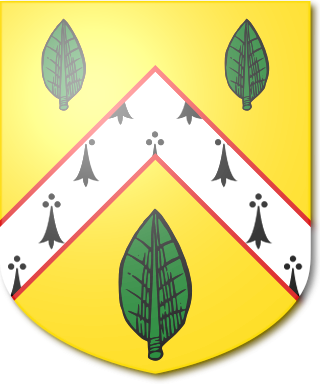
Viscount Hardinge, of Lahore and of Kings Newton in the County of Derby, is a title in the Peerage of the United Kingdom. It was created in 1846 for the soldier and Tory politician Sir Henry Hardinge. His son, the second Viscount, represented Downpatrick in Parliament. His great-great-grandson, the sixth Viscount, succeeded a distant relative as eighth Baronet, of Belle Isle in the County of Fermanagh, in 1986. This title had been created in the Baronetage of the United Kingdom 1801 for Richard Hardinge. He was the third son of Nicolas Hardinge, younger brother of Reverend Henry Hardinge and uncle of the latter's third son Henry Hardinge, 1st Viscount Hardinge. The baronetcy was created with special remainder to the heirs male of Richard Hardinge's father.

The Antrobus Baronetcy, of Antrobus in the County Palatine of Chester, is a title in the Baronetage of the United Kingdom.

The Anson baronetcy, of Birch Hall in the County Palatine of Lancaster, is a title in the Baronetage of the United Kingdom held by a branch of the Anson family. It was created on 30 September 1831 for William Anson. He was the third son of George Anson; his elder brothers were Thomas Anson, 1st Viscount Anson, and General Sir George Anson. Sir William was the uncle of Thomas Anson, 1st Earl of Lichfield, and Major-General George Anson and the great-nephew of George Anson, 1st Baron Anson. His grandson, the third Baronet, was a lawyer and Liberal Unionist politician. He never married and was succeeded by his nephew, the fourth Baronet. He was the only son of Frederick Arthur Anson, third son of the second Baronet. The fourth baronet drowned in the Thames on an outing of The Coterie in July 1914, after he jumped into the river encouraged by lady Diana Manners. He had not married and on his death the title passed to his first cousin, the fifth Baronet, the eldest son of Rear-Admiral Algernon Horatio Anson (1854–1913), fourth and youngest son of the second Baronet. He was killed in action in the First World War. He was unmarried and was succeeded by his younger brother, the sixth Baronet. His elder son, the seventh baronet, was a Rear-Admiral in the Royal Navy. As of 2021 the title is held by the latter's son, the eighth Baronet, who succeeded in 2018.
The Langham Baronetcy, of Cottesbrooke in the County of Northampton, is a title in the Baronetage of England. It was created on 7 June 1660 for John Langham, Member of Parliament for the City of London in 1654 and for Southwark in 1660 and 1661. The second Baronet was Member of Parliament for Northamptonshire and Northampton while the third Baronet sat for Northampton. The seventh Baronet was Member of Parliament for Northamptonshire. The tenth Baronet represented St Germans in the House of Commons. The thirteenth Baronet was a photographer, ornithologist and entomologist and served as High Sheriff of County Fermanagh in 1930.
There have been four baronetcies created for persons with the surname Bell, all in the Baronetage of the United Kingdom. One creation is extant as of 2007.

The Oakeley Baronetcy, of Shrewsbury, is a title in the Baronetage of Great Britain. It was created on 5 June 1790 for the Indian administrator Charles Oakeley. He served as Governor of Madras from 1790 to 1794. Frederick Oakeley was the second son of the first Baronet.

The Couper Baronetcy is a title in the Baronetage of the United Kingdom. It was created on 23 June 1841 for George Couper. He was a colonel in the Army and fought in the Peninsular War, served as Military Secretary to the Governor Generals of Canada, Sir James Kempt and Lord Durham, and was Comptroller of the Household and Equerry to Her Royal Highness the Duchess of Kent. The second Baronet was an administrator in India and served as Governor of the North-West Provinces between 1877 and 1882. Another member of the family to gain distinction was James Kempt Couper, second son of the first Baronet. He was a general in the Army.

The Synge Baronetcy, of Kiltrough in the County of Meath, is a title in the Baronetage of the United Kingdom. It was created on 12 August 1801 for Robert Synge. The third Baronet served as High Sheriff of County Cork in 1844. The family surname is pronounced "Sing". As of 28 February 2014 the present Baronet has not successfully proven his succession and is therefore not on the Official Roll of the Baronetage, with the baronetcy considered dormant since 2011.

The Muir Mackenzie Baronetcy, of Delvine in the County of Perth, is a title in the Baronetage of the United Kingdom. It was created on 9 November 1805 for Alexander Muir Mackenzie. Born Alexander Muir, he had assumed the additional surname of Mackenzie on succeeding to the estates of his great-uncle John Mackenzie, of Delvine, Perthshire, third son of Sir Kenneth Mackenzie, 1st Baronet, of Coul.

The Wraxall Baronetcy, of Wraxall in the County of Somerset, is a title in the Baronetage of the United Kingdom. It was created on 21 December 1813 for Nathaniel Wraxall. He was in the East India Company Civil Service, an author and member of parliament for Hindon, Ludgershall and Wallingford. His grandson, the third Baronet, was an author.

The Baronetcy of Gresley of Drakelow was created in the Baronetage of England on 29 June 1611 for George Gresley of Drakelow Hall, Derbyshire who was later High Sheriff of Derbyshire and Member of Parliament for Newcastle-under-Lyme.

The Lynch Baronetcy of Galway – which later became Lynch-Blosse Baronetcy – is a title in the Baronetage of Ireland. It was created on 8 June 1622 for Henry Lynch, a member of an Anglo-Norman family and one of the merchant Tribes of Galway. Both he and the second Baronet represented County Galway in the Irish House of Commons. The third Baronet was a Baron of the Court of Exchequer (Ireland). Forced to flee to France after the Glorious Revolution, his eldest son succeeded to the title and estates. The family seat was Athavallie House, Castlebar, County Mayo. The sixth Baronet assumed the additional surname of Blosse, having married Elizabeth, daughter and heir of Francis Barker, heir of Tobias Blosse. The seventh Baronet also served in the Irish House of Commons representing Tuam.

The Poore Baronetcy, of Rushall in the County of Wiltshire, is a dormant title in the Baronetage of Great Britain. It was created on 8 July 1795 for John Methuen Poore, with remainder, failing heirs male of his own, to his brother Edward Poore and the heirs male of his body.
There have been three baronetcies created for personswith the surname Elphinstone, two in the Baronetage of Nova Scotia and one in the Baronetage of the United Kingdom. As of 2008 two of the creations are extant while one is dormant.

The Boynton baronetcy, of Barmston in the County of York, was a title in the Baronetage of England. It was created on 15 May 1618 for Matthew Boynton, son of Sir Francis Boynton of Barmston Hall, in the East Riding of Yorkshire. The Boyntons came to Barmston following the marriage of heiress Margaret de la See to Sir Henry Barmston in the 15th century. The first Baronet married Francis Griffith, heiress of an estate at Burton Agnes including Burton Agnes Hall and Burton Agnes Manor House which the second Baronet inherited in 1647. The fifth and sixth Baronets both served as High Sheriff of Yorkshire, in 1750 and 1771 respectively. The eleventh Baronet died without male issue and the Baronetcy passed to his cousin. His estates however passed to his daughter Cicely whose husband Thomas Lamplugh Wickham changed his name on marriage to Wickham-Boynton, and later (1989) to Cunliffe-Lister relations descended from Mary Constance Boynton, wife of the 1st Earl of Swinton. The title became extinct on the death of the thirteenth Baronet in 1966.
The Jervoise, later Clarke-Jervoise Baronetcy, of Idsworth in the County of Southampton, was a title in the Baronetage of the United Kingdom. It was created on 13 November 1813 for Rev. Samuel Jervoise, born Samuel Clarke, who assumed the surname of Jervoise by royal licence in 1808.
The Ramsay baronetcy, of Balmain in the County of Kincardine, was created in the Baronetage of the United Kingdom on 13 May 1806 for Alexander Ramsay.

The Baird baronetcy of Newbyth, second creation, in the County of Haddington, was created in the Baronetage of the United Kingdom on 13 April 1809 for the soldier David Baird, grandson of William Baird, a younger son of Sir Robert Baird, 1st Baronet, of Saughtonhall. His father, William Baird, had inherited the Newbyth estate in 1745 on the death of Sir John Baird, 2nd Baronet, of the 1680 creation. The baronetcy was created with remainder to Baird's elder brother Robert Baird and the heirs male of his body. Sir David Baird died childless and was succeeded, according to the special remainder by his nephew David Baird, the second Baronet. At the death of the 6th Baronet in 2022, his fourth cousin, Sir Andrew James Baird became the 7th Baronet in April 2023.

The Blackwood baronetcy, of the Navy, was created in the Baronetage of the United Kingdom on 1 September 1814 for the Honourable Henry Blackwood, seventh son of Sir John Blackwood, 2nd Baronet and of Dorcas Blackwood, 1st Baroness Dufferin and Claneboye. He was a Vice-Admiral of the Blue in the Royal Navy and was the bearer of despatches announcing the victory of Trafalgar in 1805. The 7th Baronet succeeded as 10th Baron Dufferin and Claneboye and 11th Baronet of Killyleagh in 1988.

The Dundas baronetcy, of Beechwood in the County of Midlothian, was created in the Baronetage of the United Kingdom on 24 August 1821 for Robert Dundas. He was succeeded by his son David, the 2nd Baronet; three of his six sons, the 3rd, 4th and 5th Baronets, all succeeded in the title. The last was succeeded by his son, the 6h Baronet. He was childless and on his death in 1981 at the age of 99, the title became extinct.















